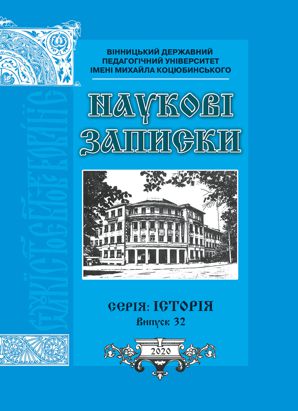Abstract
The purpose of the article is to cover the financial situation, social and living conditions, meet the cultural and educational needs of the Podilsky collective farm peasantry in the postwar period on the basis of the analysis of the archival documents of the collective farm «Red ray» p. Millers. The methodology of the research is based on the combination of general-scientific, special-historical and interdisciplinary methods of microhistorical research, taking into account the principles of historicism, systematicity, scientificity and verification. The scientific novelty lies in the author's attempt to characterize the daily life of the Podilsky collective farm peasantry during the post-war period by selecting one of the collective farms of the Podilskyi region from the standpoint of a specific microhistorical study. Conclusions. The daily life of the Podilsky collective farm peasantry during the period of post-war reconstruction was largely determined by the strategic plans of the Soviet authorities and the tasks for their realization. Immediately after the liberation of the territory from the Nazis, all the efforts of the peasantry were directed to rebuilding the war-ravaged economy and conducting a sowing campaign that coincided in time. The lack of material incentives for work was one of the most important reasons for the peasants' unfair attitude to collective labor, favoring work in their own peasant economy. To enforce discipline, the authorities practiced various measures of administrative coercion. In addition to forced labor in the state-owned collective farms, peasants were subjected to high monetary and natural taxes. They were forced to sell cattle to the state at fixed prices, required to finance local costs through additional differentiated self-taxation and the imposition of additional property responsibilities. The social sphere of the postwar village was not a priority. Extremely difficult were the social and living conditions of peasants. Despite the fact that the war was long over, some peasant families continued to live in dilapidated houses, barracks, dugouts. The quality of medical care was poor. Schools continued to operate in non-adapted premises without receiving public funding. A large proportion of rural children did not attend school because they were busy with chores. Collective houses did not fulfill their cultural leisure functions. The exceptions were the organization of celebrations of national holidays and mass sporting events.
References
АВНРДА – Архівний відділ Немирівської районної державної адміністрації.
Бажан, О. (2005). Особливості відбудовчого періоду в Українській РСР у другій половині 40-х – на початку 50-х років ХХ ст. Наукові записки національного університету Києво-Могилянська академія, Т. 41. 20–29.
Баран, В.К. & Даниленко, В.М. (1999). Україна в умовах системної кризи (1946-1980-ті рр.). К.: Видавничий дім «Альтернативи», 304 с.
Гаркуша, Л. А. (1997). Аграрна політика Радянської держави і селянства у післявоєнні роки. Проблема взаємовідносин. Питання аграрної історії України та Росії. Дніпропетровськ, 174–178.
ДАВіО – Державний архів Вінницької області.
Даниленко, В. М. (2005). Повсякденне життя українських селян у повоєнний період (1945–1953 рр.). Україна ХХ ст.: культура, ідеологія, політика: зб. наук. статей. Вип. 9. 3–18.
Коваль, М. В. (1990). УРСР у період відбудови і розвитку народного господарства (1945-1955 рр.). Український історичний журнал. № 4. 80–87.
Коляструк, О. А. (2012). Повсякденне життя українського суспільства у перші повоєнні роки (1944-1947). Наукові записки Вінницького державного педагогічного університету імені Михайла Коцюбинського. Серія : Історія. Вип. 20. 131-136. https://doi.org/2411-2143-2021-38-62-69
Кононенко, В. В. (2005a). Становище українського селянства у повоєнний період (1945–1947 рр.). Український селянин: зб. наук. праць. Черкаси, Вип. 9. 234–236.
Кононенко, В. В. (2005b). Повоєнна сільськогосподарська політика радянського уряду та її вплив на суспільно-політичні настрої населення України. Україна ХХ ст.: культура, ідеологія, політика: зб. наук. статей. Вип. 8. 198-206.
Мічуда, В. В. (2009). Побут і дозвілля сільського населення України в повоєнний період (1945–1953 рр.): (дис. … канд.. іст. наук: 07.00.01 – Історія України). Переяслав-Хмельницький, 186 с.
Нагайко, Т. Ю. (2004). Сільське житлове будівництво та житлові умови сільського населення України у період 1943–1945 рр. Український історичний збірник. Вип. 7. 353–370.
Тeрeщенко, Т. В. (2004). Соціальний протест українського селянства у період післявоєнної відбудови народного господарства (на матеріалах Центральної України). Український селянин. Вип. 8. 296-299.
Янковська, О. (2007). Матеріально-побутове становище сільського населення України в повоєнний період: земельні питання, житло, праця. Україна ХХ ст.: культура, ідеологія, політика: зб. наук. статей. Вип. 11. 389–391.

This work is licensed under a Creative Commons Attribution 4.0 International License.
Copyright (c) 2020 Scientific Papers of the Vinnytsia Mykhailo Kotsiubynskyi State Pedagogical University. Series: History





